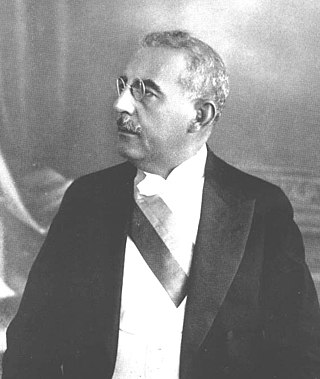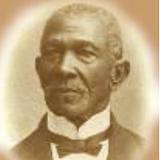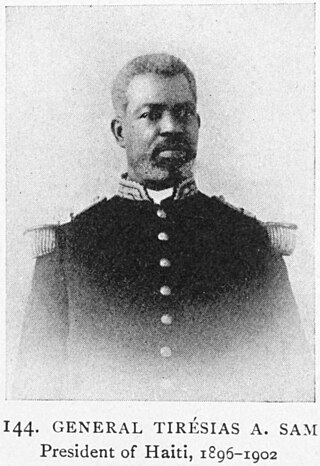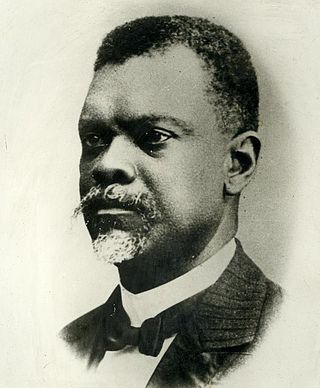
The seventh USS Washington (ACR-11/CA-11/IX-39), also referred to as "Armored Cruiser No. 11", and renamed Seattle and reclassified CA-11 and IX-39, was a United States Navy Tennessee-class armored cruiser. Commissioned in 1906, renamed in 1916, and not decommissioned until 1946, she spent periods of time in reserve. She was used for escort duties during World War I, and as a receiving ship during World War II.

The United States occupation of Haiti began on July 28, 1915, when 330 U.S. Marines landed at Port-au-Prince, Haiti, after the National City Bank of New York convinced the President of the United States, Woodrow Wilson, to take control of Haiti's political and financial interests. The July 1915 occupation took place following years of socioeconomic instability within Haiti that culminated with the lynching of President of Haiti Vilbrun Guillaume Sam by a mob angered by his decision to order the executions of political prisoners.

Sténio Joseph Vincent was President of Haiti from November 18, 1930 to May 15, 1941.

Jean Vilbrun Guillaume Sam was President of Haiti from 4 March 1915 until his assassination months later. He was the son of Tirésias Simon Sam, Haiti's president from 1896 to 1902.

Joseph Davilmar Théodore was President of Haiti from 7 November 1914 to 22 February 1915. Born in the town of Ennery in the northern half of the country, he began his career in the military and organized the cacao farmers of the north in the revolt against President Oreste Zamor. His inability to pay the farmers as he had promised for participating in the rebellion soon led to his resignation in favor of Jean Vilbrun Guillaume Sam. Théodore served as the President of the Senate of Haiti in 1910.

Philippe Sudre Dartiguenave was a Haitian political figure. He served as president of Haiti from 12 August 1915 to 15 May 1922, during the U.S. military occupation that had begun on 27 July 1915.

The Hotel Oloffson is an inn in central Port-au-Prince, Haiti. Built in the late 19th century as a private home, it was turned into a hotel in 1935, and became known for the many artists and celebrities who stayed there. The hotel was the real-life inspiration for the fictional Hotel Trianon in Graham Greene's 1966 novel The Comedians.

Paul Tirésias Augustin Simon Sam was the President of Haiti from 31 March 1896 to 12 May 1902. He resigned the presidency just before completing his six-year term.

Eustache Antoine François Joseph Louis Borno was a lawyer and Haitian politician who served as President of Haiti from 1922 to 1930 during the period of the American occupation of Haiti (1915–34).

Emmanuel Oreste Zamor was a Haitian general and politician who served as the president of Haiti in 1914. He was executed the following year after being ousted in a coup.

The Gendarmerie of Haiti, also known as the Haitian Constabulary, was a Haitian gendarmerie raised during the United States occupation of Haiti. Established in 1915 under U.S. military guidance, the gendarmerie was operational from 1916 until 1928, during which time it was Haiti's only military force, earning a reputation for active interference in civilian government that may have set the stage for the future politicization of the Armed Forces of Haiti. From 1918 to 1920, the gendarmerie fought in the Second Caco War. It was reorganized as the Haitian Guard in 1928, forming the nucleus of what would evolve into the modern military of Haiti.

Dr. Pierre François Joseph Benoit Rosalvo Bobo (1874–1929), known as Rosalvo Bobo, was a Haitian politician, and a leader of the rebel faction called the Cacos. In March of 1915, he started and led a rebellion against the government of President Vilbrun Guillaume Sam. As the rebellion was gaining momentum, Sam ordered the arrest and murder of his political opponents, but was himself killed by a mob in retaliation on 27 July 1915. This led to a breakdown of order and widespread violence in the capitol of Port-au-Prince. In response, U.S. Marines landed at Port-au-Prince on 28 July 1915, beginning the United States occupation of Haiti.

The Republic of Haiti from 1859 to 1957 was an era in Haitian history plagued with political struggles, the period of American occupation and multiple coups and elections until the Duvalier dynasty seized control of the country in 1957.
In Haitian history, Cacos were bodies of armed men, originally drawn from the country's enslaved population, who came to wield power in the mountainous regions of Haiti following the victory of the Haitian Revolution in 1804. The nickname "cacos" was derived from local terms for the red-plumed Hispaniolan trogon because the insurgents "used to hide, like the bird of the same name, under the leaves so as to come unexpectedly upon and attack their enemy."
The Republic of Cuba had maintained neutrality during much of World War I until German submarine warfare resumed on February 1, 1917. On April 7, one day after the United States entered the war, Cuba declared war on Germany and began to support the Allied war effort. Cuba also declared war on Austria-Hungary later that year, on December 16.
The Les Cayes massacre, also known as the Marchaterre massacre, was a massacre on 6 December 1929 in Les Cayes perpetrated by United States Marine Corps (USMC) troops against Haitians protesting the United States occupation of Haiti. The massacre was instrumental in placing pressure on the United States to withdraw its occupying forces from Haiti.

German–Haitian relations date back to the time before the country's independence. They were characterized by trade in the 19th century. In the 20th century, they lost importance due to political developments in both Germany and Haiti.

Edmond Sylvestre Polynice was a Haitian military and political figure who served as interim President of Haiti twice in 1914, both times acting as head of a Committee of Public Safety. Previously, Polynice had been a member of the May 1902 committee headed by Pierre Théoma Boisrond-Canal.
The Revolutionary Committee was a governmental council that governed Haiti from July 28 to August 11, 1915. The committee took power after the death of Vilbrun Guillaume Sam and de facto controlled the country's capital, Port-au-Prince, with its activities having as its background the American invasion of Haiti and the rebellion of Rosalvo Bobo. Committee was composed of: Charles de Delva, Charles Zamor, Edmond Polynice, Léon Nau, Ermane Robin, Eribert Saint-Vil Nöel and Samson Monpoint.














